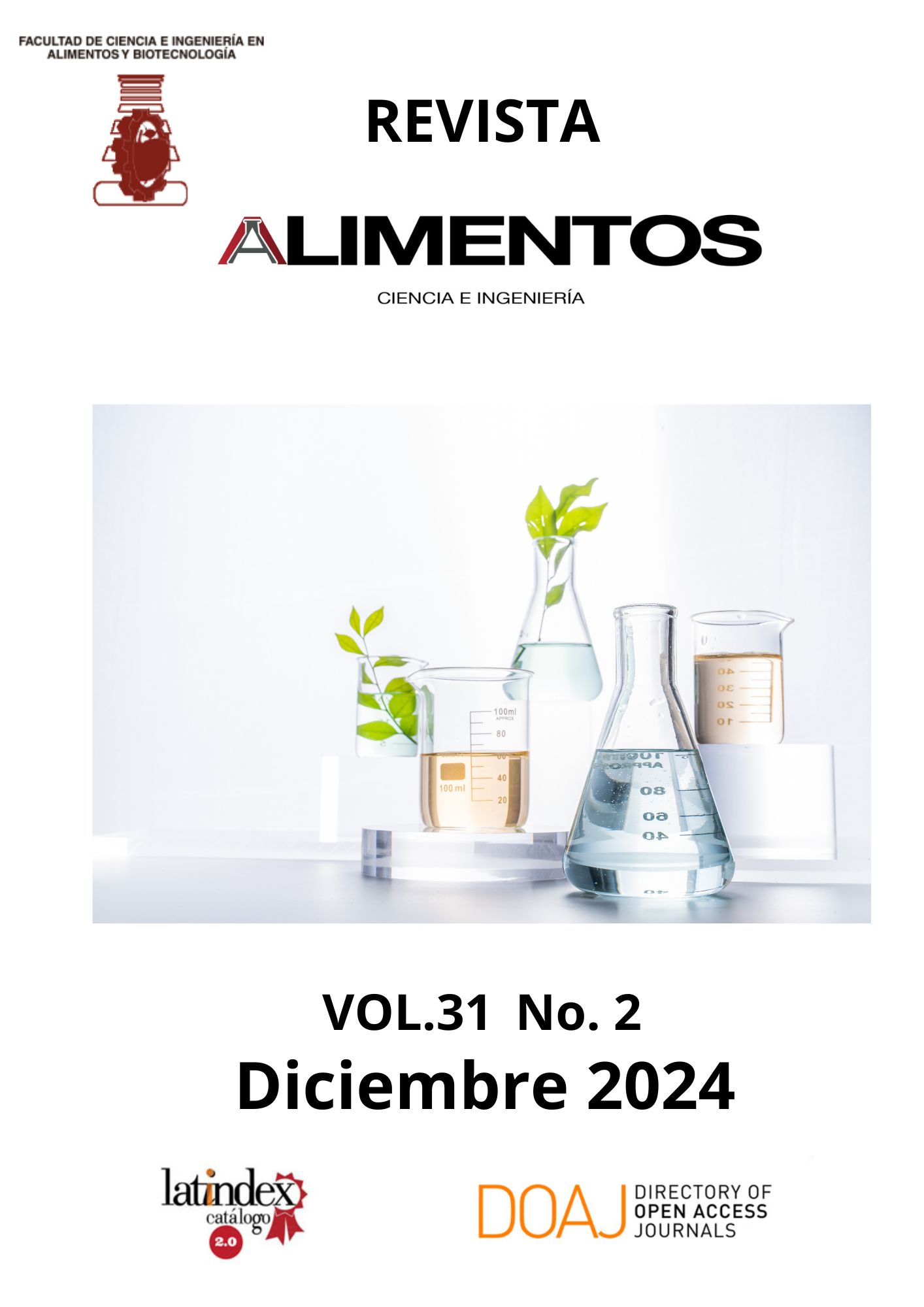Effects of Vermicompost Inclusion on Water Quality, Feed Intake, and Growth Parameters of Nile Tilapia (Oreochromis niloticus)
Contenido principal del artículo
Resumen
Fertilizing the ponds with Vermicompost did not affect the survival rate (P = 0.630) when 0, 3000, and 6000 g of fertilizer were included per pound. The final weight, the weight gain and the percentage of weight gain, the specific daily growth rate, and the feed conversion ratio were different between the fertilization treatments with 0, 3000, and 6000 g/bag of Vermicompost and ponds. The higher yields are observed when fertilized with 3000 g/bag of Vermicompost and ponds. Vermicompost fertilization does not affect water quality. The water quality, under the conditions of this study, has been classified within good quality parameters for the culture of red tilapia. In conclusion, vermicompost inclusion as a feed fertilizer for water microorganisms will serve as natural feed for the general development of Nile tilapias and contribute to promoting the production of plankton in adequate quantities. Water quality is one of the important factors for successful pond fish culture and the inclusion of vermicompost will not alter its physical-chemical parameters, allowing a fast and normal growth of this species.
Descargas
Detalles del artículo

Esta obra está bajo una licencia internacional Creative Commons Atribución-NoComercial 4.0.
Aquellos autores/as que tengan publicaciones con esta revista, aceptan los términos siguientes:
a. Los autores/as conservarán sus derechos de copiar y redistribuir el material, bajo los términos estipulados en la Licencia de reconocimiento, no comercial que permite a terceros compartir la obra bajo las siguientes condiciones:
Atribución: debe dar el crédito apropiado, proporcionar un enlace a la licencia e indicar si se realizaron cambios. Puede hacerlo de cualquier manera razonable, pero no de ninguna manera que sugiera que el licenciante lo respalda a usted o su uso.
No comercial: no puede utilizar el material con fines comerciales.
Sin restricciones adicionales: no puede aplicar términos legales ni medidas tecnológicas que restrinjan legalmente a otros hacer cualquier cosa que la licencia permita.
Citas
El-Ouny, Y.M.; Maulu, S.; Zaki, M.A.; Helaly, A.A.; Nour, A.A.M.; ElBasuini, M.F.; ... Khalil, H.S. Effect of fishmeal replacement with dried red wigglers (Eisenia fetida) worm meal on growth and feed utilization, production efficiency, and serum biochemistry in Nile tilapia (Oreochromis niloticus) fingerlings. Aquac Rep. 2023, 29, 101518. https://doi.org/10.1016/j.aqrep.2023.101518
Musyoka, S.N.; Liti, D.; Ogello, E.O.; Meulenbroek, P.; Waidbacher, H. Earthworm, Eisenia fetida, bedding meal as a potential cheap fishmeal replacement ingredient for semi‐intensive farming of Nile Tilapia, Oreochromis niloticus. Aquac Res. 2020, 51(6), 2359-2368. https://doi.org/10.1111/are.14579
Ahmed, R.A.; Eissa, H.S.; Shafi, M.E.; Aly, M.Y.M.; Al-Kareem, O.M.A. Influence of replacement of fish meal with the earthworm Eisenia fetida on growth performance, feed utilization and blood parameters of Nile tilapia (Oreochromis niloticus). J Aquac Mar Biol. 2020, 9(3), 7-42. https://doi.org/10.15406/jamb.2020.09.00275
Debnath, S.C.; McMurtrie, J.; Temperton, B.; Delamare-Deboutteville, J.; Mohan, C.V.; Tyler, CR. Tilapia aquaculture, emerging diseases, and the roles of the skin microbiomes in health and disease. Aquac Int. 2023, 1-32. https://doi.org/10.1007/s10499-023-01117-4
Ahmed, M.; Abdullah, N.; Shuib, A.S.; Razak, S.A. Influence of raw polysaccharide extract from mushroom stalk waste on growth and pH perturbation induced-stress in Nile tilapia, Oreochromis niloticus. Aquac. 2017, 468, 60-70. https://doi.org/10.1016/j.aquaculture.2016.09.043
Putra, A.N.; Indayah, U.; Nokiyah, N.; Syamsunarno, M.B. Improving the quality of cassava peel meal as raw material for tilapia feed. Depik. 2022, 11(3), 319-32. https://doi.org/10.13170/depik.11.3.24620
Ng, W.K.; Romano, N. A review of the nutrition and feeding management of farmed tilapia throughout the culture cycle. Rev Aquac. 2013, 5(4), 220-254. https://doi.org/10.1111/raq.12014
Yones, A.M.M.; Metwalli, A.A. Effects of fish meal substitution with poultry by-product meal on growth performance, nutrients utilization and blood contents of juvenile Nile Tilapia (Oreochromis niloticus). J Aquac Res Dev. 2015, 7(1), 1000389. http://dx.doi.org/10.4172/2155-9546.1000389
Sampathkumar, K.; Yu, H.; Loo, S.C.J. Valorisation of Industrial Food Waste into Sustainable Aquaculture Feeds. Future Foods. 2023, 100240. https://doi.org/10.1016/j.fufo.2023.100240
Rahman, M.M.; Hajar, S.; Yunus, K.B. Comparative analysis of chemical composition of some commercially important fishes with an emphasis on various Malaysian diets. Open Chem. 2020, 18(1), 1323-1333. https://doi.org/10.1515/chem-2020-0152
Celikcan, F.; Kocak, M.Z.; Kulak, M. Vermicompost applications on growth, nutrition uptake and secondary metabolites of Ocimum basilicum L. under water stress: A comprehensive analysis. Ind Crops Prod. 2021, 171, 113973. https://doi.org/10.1016/j.indcrop.2021.113973
Ghosh, C. Integrated vermi-pisciculture–an alternative option for recycling of solid municipal waste in rural India. Bioresour Technol. 2004, 93(1), 71-75. https://doi.org/10.1016/j.biortech.2003.09.014
Montoya‐Camacho, N.; Marquez‐Ríos, E.; Castillo‐Yáñez, F.J.; Cárdenas, J.L.; López‐Elías, J.A.; Ruíz‐Cruz, S.; ... Ocaño‐Higuera, V.M. Advances in the use of alternative protein sources for tilapia feeding. Rev Aquac. 2019, 11(3), 515-526. https://doi.org/10.1111/raq.12243
Bansal, S.; Kapoor, K.K. Vermicomposting of crop residues and cattle dung with Eisenia foetida. Bio Tech. 2000, 73(2), 95-98. https://doi.org/10.1016/S0960-8524(99)00173-X
Pirarat, N.; Pinpimai, K.; Endo, M.; Katagiri, T.; Ponpornpisit, A.; Chansue, N.; Maita, M. Modulation of intestinal morphology and immunity in nile tilapia (Oreochromis niloticus) by Lactobacillus rhamnosus GG. Res Vet Sci. 2011, 91(3), e92-e97. https://doi.org/10.1016/j.rvsc.2011.02.014
InfoStat. Software Estadístico. Versión 2020. Universidad Nacional de Córdoba. Argentina. 2020.
Musyoka, S.N.; Nairuti, R. Application of Vermicompost Fertilizer in Aquaculture Nutrition. 2021. https://doi.org/10.5772/intechopen.100326
Chakrabarty, D.; Das, S.K.; Das, M.K. Relative efficiency of vermicompost as direct application manure in pisciculture. PAWE. 2009, 7:27-32. https://doi.org/10.1007/s10333-008-0145-7
Heneash, A.M.M.; Alprol, A.E. Monitoring of water quality and zooplankton community in presence of different dietary levels of commercial wood charcoal of red tilapia. J Aquac Res Dev. 2020, 11, 1-6. https://doi.org/10.35248/2155-9546.20.11.592
Hasan, M.N.; Rahman, M.S.; Hosen, M.F.; Bashar, M.A. Effects of addition of tilapia on the abundance of periphyton in freshwater prawn culture ponds with periphyton substrates. JBAU. 2012, 10(2), 313-324. http://dx.doi.org/10.3329/jbau.v10i2.14924
Diana, J.S.; Szyper, J.P.; Batterson, T.R.; Boyd, C.E.; Piedrahita, R.H. Water quality in ponds. Dyn Pond Aquac. 2017, 53-71. https://doi.org/10.1201/9780203759028
Makori, A.J.; Abuom, P.O.; Kapiyo, R.; Anyona, D.N.; Dida, G.O. Effects of water physico-chemical parameters on tilapia (Oreochromis niloticus) growth in earthen ponds in Teso North Sub-County, Busia County. Fish Aquatic Sci. 2017, 20(1),1-10. https://doi.org/10.1186/s41240-017-0075-7


